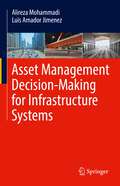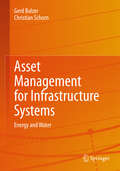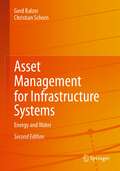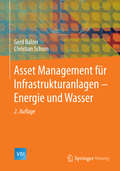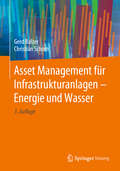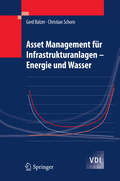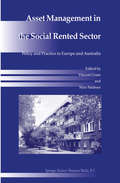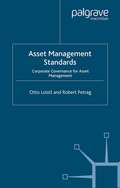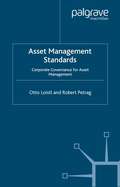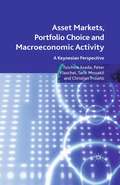- Table View
- List View
Asset Management and Institutional Investors: Methods and Tools for Asset Allocation, Portfolio Management and Performance Evaluation (Contributions to Finance and Accounting)
by Ignazio Basile Pierpaolo FerrariThis second edition of the book analyses the latest developments in investment management policy for institutional investors. It is divided into four parts, which have been updated to include the newest approaches and strategies in asset allocation, portfolio management and performance evaluation. The first part analyses the different types of institutional investors, i.e. institutions that professionally manage portfolios of financial and real assets on behalf of a wide range of individuals. This part goes on with an in-depth analysis of the economic, technical and regulatory characteristics of the various categories of investment funds and of other types of asset management products, which have a high rate of substitutability with investment funds and represent their natural competitors. The second part of the book identifies and investigates the stages of the investment portfolio management. Given the importance of strategic asset allocation in explaining the ex post performance of any type of investment portfolio, this part provides an in-depth analysis of asset allocation methods, illustrating the different theoretical and operational solutions available to institutional investors. The third part describes performance assessment, its breakdown and risk control, with an in-depth examination of performance evaluation techniques, returns-based style analysis approaches and performance attribution models. Finally, the fourth part deals with the subject of diversification into alternative asset classes, identifying the common characteristics and their possible role within the framework of investment management policy. This part analyses hedge funds, private equity, private debt, real estate, infrastructures, commodities and currency overlay techniques.
Asset Management at Central Banks and Monetary Authorities: New Practices in Managing International Foreign Exchange Reserves
by Jacob BjorheimIn response to the Global Financial Crisis and the COVID-19 pandemic, central banks have used all available instruments in their monetary policy tool-kit to avoid financial market disruptions and a collapse in real economic activities. These actions have expanded the size of their balance sheets and altered the composition of the asset-side. This edited book highlights how these assets are managed, providing an intellectual and practical contribution to an under-researched field of central bank responsibilities. It first reviews the sources and uses of domestic and international assets and how they complement—or possibly conflict with—the implementation of monetary policy goals. Next, the book examines the asset management mandate in a balance sheet context before turning to the investment decision-making process from strategic and tactical asset allocation to investment strategies, risk management, governance, reporting and control. Finally, it presents new developments in the field of managing assets at central banks. The individual chapters are written by central bankers, academics, and representatives from International Financial Institutions, each representing a particular aspect of the asset management practice.Practical and powerful insights from a hall of fame of investors, central bankers and scholars, are packed into this one volume. If you could have only one book on central bank asset management, this would be it. —Peter R. Fisher, Clinical Professor, Tuck School of Business at DartmouthJacob Bjorheim draws on his long experience in sovereign asset management to pull together a rich collection of insights from a broad range of expertise. Asset management at central banks has evolved and expanded considerably over the past decade. This book is a timely source of information and guidance. —Guy Debelle, Deputy Governor, Reserve Bank of AustraliaCentral bank balance sheets have grown at a tremendous pace over the last decade and a half. Drawing on contributions from scholars and experienced central bankers from around the world, this timely and insightful book sheds light on how central banks are, and should be, managing their growing balance sheets. —Kjell G. Nyborg, Chaired Professor of Finance, University of Zurich, Author of Collateral Frameworks: The Open Secret of Central BanksCentral banks and monetary authorities are charged with, and being held accountable for, managing portfolios of foreign currency assets of unprecedented size. The essays in this admirable book, written by some of the worlds most highly experienced officials, cover the full range of why and how this is currently being done and how new developments are affecting old practices. Interesting conceptually and immensely useful practically. —William White, Senior Fellow at the C.D. Howe Institute, former Head of the Monetary and Economic Department with the Bank for International Settlements (BIS) and chairman of the Economic and Development Review Committee at the OECDAn excellent and timely review of modern international reserve management, which ought to be read by everyone working with, or simply interested in, international asset management and finance as well as monetary and economic policy. The spectrum of authors is broad and their combined insight is very valuable. —Tom A. Fearnley, Investment Director, Norwegian Ministry of FinanceWith “Asset Management at Central Banks and Monetary Authorities”, Jacob Bjorheim has achieved an editorial tour de force. The book assembles the insightful views of the leading experts in the field, both from an academic and practitioners’ perspective. It bridges the gap between the macroeconomics of central banks and the financial management of their reserves. A must read to understand how central banks are special in the group of institutional investors. —Eric Bouyé, Head of Asset Allocation and Quantitative S
Asset Management Decision-Making For Infrastructure Systems
by Alireza Mohammadi Luis Amador JimenezThis textbook provides practical and concrete guidance for the step-by-step implementation of decision-making for infrastructure asset management. Examples are used to illustrate how data from condition assessment are used to develop performance models, to estimate the effectiveness of investments that are prioritized and scheduled to accomplish reliable and convenient infrastructure for the wellbeing of the public and regional economic competitiveness. Book illustrates numerous worked problems to clarify ambiguity in developing a decision-making platform to prioritize assets and distribute budgets effectively and efficiently.Ensures reader understanding of the benefits and challenges of infrastructure asset management; Provides a step-by-step guide for the development of each component of an asset management decision-making system;Includes worked examples to clarify decision-making and budget allocation process.
Asset Management Excellence: Optimizing Equipment Life-Cycle Decisions (Mechanical Engineering)
by Don M. Barry John D. Campbell Andrew K. S. Jardine Joel McGlynnThis is the third edition of Asset Management Excellence: Optimizing Equipment Life-Cycle Decisions. This edition acknowledges and introduces the many changes to the Asset Management business while continuing to explain the supporting fundamentals. Since the second edition, there have been many influences of change in asset management, society’s expectations, and supporting technologies. In this edition, the contributors have revisited the content and have updated and added insights and information based on the emerging influences in thinking and the continued evolution of applied technologies since the prior editions. New in the Third Edition: Updates across each of the second edition chapters to align with today’s insights Updates on technologies now available to support Asset Management, including related software packaging, the Internet of Things (IoT), Machine Learning, and Artificial Intelligence Insights on how Information Technology can step up to help an asset-intensive organization compete, drive to operational excellence and automation A chapter on sustainability and the influence Asset Management may have on this higher-focus priority A chapter on change enablement as the process and technology changes impact the various stakeholders of asset-intensive organizations The fundamentals of Asset Management are essential as Asset-intensive organizations look to technologies to help them compete. AI is becoming pervasive but must be confirmed and aligned with the fundamentals. This edition will provoke thought as each organization determines its next steps toward its new challenges in Asset Management.
Asset Management Excellence: Optimizing Equipment Life-Cycle Decisions, Second Edition
by John D. Campbell Andrew K. S. Jardine Joel McGlynnDuring the eight years since the publication of Maintenance Excellence: Optimizing Equipment Life-Cycle Decisions the business environment has changed drastically. Globalization, consolidation, and changes in technology challenge asset management and maintenance professionals to be more efficient. Globalization and consolidation have been particula
Asset Management Excellence: Optimizing Equipment Life-Cycle Decisions (Mechanical Engineering)
by John D. Campbell Andrew K. S. Jardine Joel McGlynn Don M. BarryThis is the third edition of Asset Management Excellence: Optimizing Equipment Life-Cycle Decisions. This edition acknowledges and introduces the many changes to the Asset Management business while continuing to explain the supporting fundamentals. Since the second edition, there have been many influences of change in asset management, society’s expectations, and supporting technologies. In this edition, the contributors have revisited the content and have updated and added insights and information based on the emerging influences in thinking and the continued evolution of applied technologies since the prior editions. New in the Third Edition: Updates across each of the second edition chapters to align with today’s insights Updates on technologies now available to support Asset Management, including related software packaging, the Internet of Things (IoT), Machine Learning, and Artificial Intelligence Insights on how Information Technology can step up to help an asset-intensive organization compete, drive to operational excellence and automation A chapter on sustainability and the influence Asset Management may have on this higher-focus priority A chapter on change enablement as the process and technology changes impact the various stakeholders of asset-intensive organizations The fundamentals of Asset Management are essential as Asset-intensive organizations look to technologies to help them compete. AI is becoming pervasive but must be confirmed and aligned with the fundamentals. This edition will provoke thought as each organization determines its next steps toward its new challenges in Asset Management.
Asset Management for Infrastructure Systems: Energy and Water
by Gerd Balzer Christian SchornThe book offers a broad overview of asset management processes for different utilities, with a special emphasis on energy and water. It provides readers with important practical considerations concerning the development of new competitive structures and procedures for guaranteeing a sufficient supply of energy and water in a regulated environment, using clearly defined technical and economic cornerstones. On the one hand asset owners expect suitable interests from their investment and business growth; on the other hand regulators focus more on a reliable and cost-effective customer supply. This book shows how to take into consideration these different perspectives in the process of designing new structures and how to guarantee organizational transparency. Based on the major tasks of an asset manager, it describes essential principles and boundary conditions for ensuring the optimal use of resources in a network, such as investment and maintenance strategies, equipment service life, investment and operational costs, etc. Moreover, it points out their impact on the organization of the company, including the necessary IT landscape and computer programs. The book is the English translation of Asset Management für Infrastrukturanlagen - Energie und Wasser1, written by the same authors and published by Springer in 2014.
Asset Management for Infrastructure Systems: Energy and Water
by Gerd Balzer Christian SchornThis book offers a broad overview of asset management processes for different utilities, with a special emphasis on energy and water. It provides readers with important practical considerations concerning the development of new competitive structures and procedures for guaranteeing a sufficient supply of energy and water in a regulated environment, using clearly defined technical and economic cornerstones. On the one hand, asset owners expect suitable interests from their investment and business growth; on the other hand, regulators focus more on a reliable and cost-effective customer supply. This book shows how to take into consideration these different perspectives in the process of designing new structures, and how to guarantee organizational transparency. It describes essential principles and boundary conditions for ensuring the optimal use of resources in a network, covering issues relating to equipment service life, IT landscape and computer programs, operational costs management, and investment and maintenance strategies, highlighting their impact on the organization of the company. This thoroughly revised and updated second edition, includes extensive information about IEC standard (IEC/TS 63060), and cover operation research methods focusing on the optimization of the maintenance tasks. Furthermore, a discussion on the political environment has been included, with a special emphasis on the European situation and the “Green Deal”: specifically, some measures to cope with the topic of energy transition are presented. Last, but not least, a brand-new chapter on condition assessment has been included.
Asset Management für Infrastrukturanlagen - Energie und Wasser (VDI-Buch)
by Gerd Balzer Christian SchornDie Aufgabe eines Versorgungsunternehmens (Elektrizität, Gas, Wasser) ist es, eine ausreichende Versorgung unter technischen und finanziellen Randbedingungen zu ermöglichen. Aufgrund der Veränderungen dieser Randbedingungen seit der ersten Auflage war es notwendig, einige Abschnitte zu überarbeiten bzw. neu hinzuzufügen. Hierzu gehört die Ergänzung der neuen Instandhaltungsnorm (DIN V VDE 0109), die von der Deutschen Elektrotechnischen Kommission (DKE) herausgegeben wurde, als auch Überlegungen, wie mit Hilfe von speziellen Verfahren aus dem Bereich des Operation Research eine Optimierung der Instandhaltungsaufgaben möglich ist. Darüber hinaus erfordert die Dezentralisierung in der elektrotechnischen Energieversorgung neue Planungsprämissen, die im Abschnitt „Netzplanung in Smart Grid“ dargestellt sind. Diese haben auch Auswirkungen auf die Asset Strategien. Es zeigt sich, dass das Arbeitsgebiet „Asset Management“ aufgrund der sich ändernden Rahmenbedingungen noch nicht abgeschlossen ist.
Asset Management für Infrastrukturanlagen - Energie und Wasser
by Gerd Balzer Christian SchornDie Aufgabe eines Versorgungsunternehmens (Elektrizität, Gas, Wasser) ist es, eine ausreichende Versorgung unter technischen und finanziellen Randbedingungen zu ermöglichen. Seit der zweiten Auflage dieses Buches haben sich deutliche Veränderungen in den Rahmenbedingungen ergeben, wodurch die Komplexität im Anlagenmanagement stark angestiegen ist. Dies ist einerseits durch gesetzliche und normative Weiterentwicklungen, andererseits durch Themen wie Energiewende und Umweltschutz begründet. Dadurch wurde es notwendig, einige Abschnitte zu überarbeiten beziehungsweise neue Kapitel hinzuzufügen. Hierzu gehören sowohl die Ergänzung der IEC-Norm (IEC/TS 63060), als auch Erweiterungen aus dem Bereich des Operation Research, mit dem eine Optimierung der Instandhaltungsaufgaben möglich ist. Darüber hinaus erfordert die tiefgreifende Veränderung im Energieversorgungssystem durch die Energiewende neue Planungsstrategien sowie den Einsatz neuer innovativer Technologien wie Energiespeicher, automatisierte Betriebsführung und Ähnliches. Einen großen Einfluss hat mittlerweile auch das Thema Digitalisierung, weshalb die IT-Sicherheit als neues Thema aufgenommen wurde. Es zeigt sich, dass das Arbeitsgebiet Asset Management aufgrund der sich ändernden Rahmenbedingungen noch nicht abgeschlossen ist.
Asset Management für Infrastrukturanlagen - Energie und Wasser (VDI-Buch)
by Gerd Balzer Christian SchornDie Aufgabe eines Versorgungsunternehmens besteht darin, seine Kunden zuverlässig mit Elektrizität, Gas oder Wasser zu versorgen. Um diese Aufgabe in einem regulierten Markt zu erfüllen, können Versorgungsunternehmen neue Strukturen und Verfahren entwickeln. Damit sie dabei sowohl den Eigentümern als auch der Regulierungsinstanz gerecht werden, ist es sinnvoll, bisherige Prozesse neu zu strukturieren. Die Autoren liefern einen umfassenden Überblick zu Asset-Management-Prozessen, die derzeit in Versorgungsunternehmen umgesetzt werden.
Asset Management in the Social Rented Sector: Policy and Practice in Europe and Australia
by NicoNieboer VincentGruisThis book fills an important gap in housing research, covering the impact of recent changes in housing policies and markets on the development of state-of-the-art asset management within the social rented sector in various countries.
Asset Management of Bridges: Proceedings of the 9th New York Bridge Conference, August 21-22, 2017, New York City, USA
by Khaled M. MahmoudMaintaining bridges in good condition has extended service life and proven to be more cost effective than allowing degradation to advance, necessitating costlier bridge rehabilitation or replacement projects. Preventive maintenance is therefore an important tool to retard deterioration and sustain the safe operation of bridges. This includes a continuous effort of periodic inspections, condition evaluations and prioritizing repairs accordingly. The above measures define the framework for asset management of bridges. On August 21-22, 2017, bridge engineering experts from around the world convened at the 9th New York City Bridge Conference to discuss issues of construction, design, inspection, monitoring, preservation and rehabilitation of bridge structures. This volume documents their contributions to the safe operation of bridge assets.
Asset Management of Bridges: Proceedings of the 9th New York Bridge Conference, August 21-22, 2017, New York City, USA
by Khaled M. MahmoudMaintaining bridges in good condition has extended service life and proven to be more cost effective than allowing degradation to advance, necessitating costlier bridge rehabilitation or replacement projects. Preventive maintenance is therefore an important tool to retard deterioration and sustain the safe operation of bridges. This includes a continuous effort of periodic inspections, condition evaluations and prioritizing repairs accordingly. The above measures define the framework for asset management of bridges. On August 21-22, 2017, bridge engineering experts from around the world convened at the 9th New York City Bridge Conference to discuss issues of construction, design, inspection, monitoring, preservation and rehabilitation of bridge structures. This volume documents their contributions to the safe operation of bridge assets.
Asset Management Standards: Corporate Governance for Asset Management (Finance and Capital Markets Series)
by O. Loistl Robert PetragAsset management Standards discussion's main focus on governance issues matches the established structural components of the Asset Management Standard's systematic classification. Numerous innovations called for a nearly complete revision. This new edition offers again a reliable source of information on the major issues in asset management.
Asset Management Standards: Corporate Governance for Asset Management (Finance and Capital Markets Series)
by Otto Loistl Robert PetragAsset management standards are crucial for building trust between investors and capital market experts. The issue of corporate governance has been thrown into the spotlight by the disastrous collapse of Enron and the implications for the industry. The proposed standards are relevant for the entire fund industry, regulators, providers of pension plans and portfolio managers. Produced in association with the European Federation of Financial Analysts Societies, this book aims to provide a well-founded basis for development of the content of asset management standards in the UK, the US and the EU. It contains a detailed overview of the current position, outlines planned developments and discusses underlying problems.
Asset Markets, Portfolio Choice and Macroeconomic Activity: A Keynesian Perspective
by T. Asada P. Flaschel Tarik Mouakil Christian ProañoThis book extends the KMG framework (Keynes, Meltzer, Goodwin) and focuses on financial issues. It integrates Tobin's macroeconomic portfolio approach and emphasizes the issue of stock-flow consistency.
Asset Pedagogies in Latino Youth Identity and Achievement: Nurturing Confianza
by Francesca A. LópezAsset Pedagogies in Latino Youth Identity and Achievement explores the theory, research, and application of asset-based pedagogies to counter approaches that fail to challenge deficit views of youth. Presenting details on the role of teachers’ knowledge about students’ language and culture as strengths as opposed to deficiencies, Francesca A. López connects classroom practices to positive outcomes, preparing teachers to use asset pedagogies to promote academic achievement and implement asset-based teaching practices. Making thorough use of examples from research both in and out of the classroom and concluding with concrete applications from experienced educators, this book provides future teachers with a critical understanding of how to support Latino youth.
Asset Pedagogies in Latino Youth Identity and Achievement: Nurturing Confianza
by Francesca A. LópezAsset Pedagogies in Latino Youth Identity and Achievement explores the theory, research, and application of asset-based pedagogies to counter approaches that fail to challenge deficit views of youth. Presenting details on the role of teachers’ knowledge about students’ language and culture as strengths as opposed to deficiencies, Francesca A. López connects classroom practices to positive outcomes, preparing teachers to use asset pedagogies to promote academic achievement and implement asset-based teaching practices. Making thorough use of examples from research both in and out of the classroom and concluding with concrete applications from experienced educators, this book provides future teachers with a critical understanding of how to support Latino youth.
Asset Price Dynamics, Volatility, and Prediction
by Stephen J. TaylorThis book shows how current and recent market prices convey information about the probability distributions that govern future prices. Moving beyond purely theoretical models, Stephen Taylor applies methods supported by empirical research of equity and foreign exchange markets to show how daily and more frequent asset prices, and the prices of option contracts, can be used to construct and assess predictions about future prices, their volatility, and their probability distributions. Stephen Taylor provides a comprehensive introduction to the dynamic behavior of asset prices, relying on finance theory and statistical evidence. He uses stochastic processes to define mathematical models for price dynamics, but with less mathematics than in alternative texts. The key topics covered include random walk tests, trading rules, ARCH models, stochastic volatility models, high-frequency datasets, and the information that option prices imply about volatility and distributions. Asset Price Dynamics, Volatility, and Prediction is ideal for students of economics, finance, and mathematics who are studying financial econometrics, and will enable researchers to identify and apply appropriate models and methods. It will likewise be a valuable resource for quantitative analysts, fund managers, risk managers, and investors who seek realistic expectations about future asset prices and the risks to which they are exposed.
Asset Price Dynamics, Volatility, and Prediction (PDF)
by Stephen J. TaylorThis book shows how current and recent market prices convey information about the probability distributions that govern future prices. Moving beyond purely theoretical models, Stephen Taylor applies methods supported by empirical research of equity and foreign exchange markets to show how daily and more frequent asset prices, and the prices of option contracts, can be used to construct and assess predictions about future prices, their volatility, and their probability distributions. Stephen Taylor provides a comprehensive introduction to the dynamic behavior of asset prices, relying on finance theory and statistical evidence. He uses stochastic processes to define mathematical models for price dynamics, but with less mathematics than in alternative texts. The key topics covered include random walk tests, trading rules, ARCH models, stochastic volatility models, high-frequency datasets, and the information that option prices imply about volatility and distributions. Asset Price Dynamics, Volatility, and Prediction is ideal for students of economics, finance, and mathematics who are studying financial econometrics, and will enable researchers to identify and apply appropriate models and methods. It will likewise be a valuable resource for quantitative analysts, fund managers, risk managers, and investors who seek realistic expectations about future asset prices and the risks to which they are exposed.
Asset Price Response to New Information: The Effects of Conservatism Bias and Representativeness Heuristic (SpringerBriefs in Finance)
by Guo Ying LuoAsset Price Response to New Information examines the effect of two types of psychological biases (namely, conservatism bias and representativeness heuristic) on the asset price reaction to new information. The author constructs various models of a competitive securities market or a security market allowing for strategic interaction among traders to prove rigorously that either conservatism or representativeness is capable of generating both asset price overreaction and underreaction to new information. The results shed some new insights on the phenomena of the asset price overreaction and underreaction to new information. In the literature, very little has been published in this area of behavioral finance. This volume will appeal to graduate-level students and researchers in finance, behavioral finance, and financial engineering.
Asset Prices and Monetary Policy (National Bureau of Economic Research Conference Report)
by John Y. CampbellEconomic growth, low inflation, and financial stability are among the most important goals of policy makers, and central banks such as the Federal Reserve are key institutions for achieving these goals. In Asset Prices and Monetary Policy, leading scholars and practitioners probe the interaction of central banks, asset markets, and the general economy to forge a new understanding of the challenges facing policy makers as they manage an increasingly complex economic system. The contributors examine how central bankers determine their policy prescriptions with reference to the fluctuating housing market, the balance of debt and credit, changing beliefs of investors, the level of commodity prices, and other factors. At a time when the public has never been more involved in stocks, retirement funds, and real estate investment, this insightful book will be useful to all those concerned with the current state of the economy.
Asset Prices and Monetary Policy (National Bureau of Economic Research Conference Report)
by John Y. Campbell National Bureau of Economic Research StaffEconomic growth, low inflation, and financial stability are among the most important goals of policy makers, and central banks such as the Federal Reserve are key institutions for achieving these goals. In Asset Prices and Monetary Policy, leading scholars and practitioners probe the interaction of central banks, asset markets, and the general economy to forge a new understanding of the challenges facing policy makers as they manage an increasingly complex economic system. The contributors examine how central bankers determine their policy prescriptions with reference to the fluctuating housing market, the balance of debt and credit, changing beliefs of investors, the level of commodity prices, and other factors. At a time when the public has never been more involved in stocks, retirement funds, and real estate investment, this insightful book will be useful to all those concerned with the current state of the economy.
Asset Prices and the Real Economy (Studies in Banking and International Finance)
by Forrest Capie Geoffrey E. WoodThe recession which many countries experienced in the early 1990s had certain unusual aspects. Most notably, and common to all countries, was the behaviour of asset prices relative to the general price level. In consequence, reasons were sought to explain the special characteristics of the recession and as a result of the behaviour of asset prices attention turned to 'Debt-Deflation Theories' associated in different forms with Keynes and Irving Fisher. The contributors to this volume discuss the significance of debt deflation. Their striking common feature is that, on the evidence presented here, the behaviour of asset prices should not be of great concern to policy makers, or to those attempting to understand economic behaviour. However, residual doubts remain over the Japanese case.


